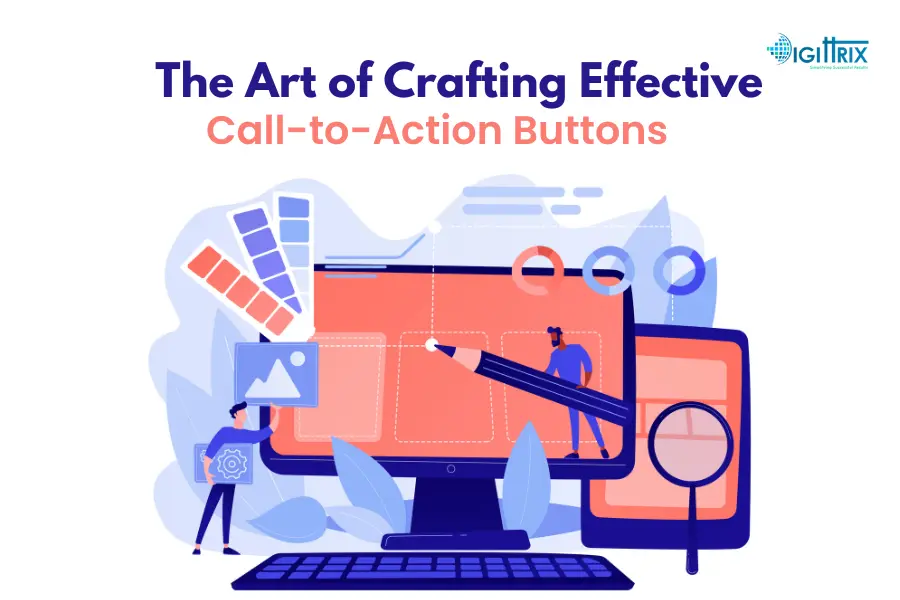Creating clear and action-focused call-to-action buttons helps guide users, improve clicks, and support better results across websites, apps, or digital campaigns.
Highlights
With Over 14 years of Experience in the IT Field, Helping Companies Optimise there Products for more Conversions

In today's digital age, a compelling call-to-action (CTA) button has become an indispensable tool for driving conversions and engaging users. Whether you're a seasoned marketer, an aspiring entrepreneur, or a curious web designer, this blog is your ultimate guide to understanding the strategic nuances and creative elements behind designing CTAs that captivate audiences and prompt them to take action.
Join us on this enlightening journey as we explore the psychology, design principles, and best practices that will empower you to create irresistible CTAs that skyrocket your click-through rates and maximize your business potential. Get ready to transform your digital presence and unlock the secrets of crafting CTAs that truly convert.
Designing a website? Learn how to create a site that encourages return visits and builds user trust.
In order to craft effective call-to-action buttons, it is crucial to understand the psychology behind user behaviour. By tapping into the motivations, desires, and decision-making processes of users, you can create CTAs that resonate with them on a deeper level.
Understanding how emotions impact decision-making is key to creating compelling CTAs. By evoking emotions such as excitement, fear of missing out, or a sense of urgency, you can drive users to take immediate action. According WordStream strong and clear action verbs in CTAs may help increase click-through rates by up to 13%.
Users need to know what they will gain or achieve by clicking on your CTA. Communicating a clear value proposition that addresses their pain points or offers a solution will make your CTA more persuasive.
People tend to follow the actions of others when making decisions. Incorporating social proof elements such as testimonials, reviews, or trust symbols in your CTAs can enhance credibility and increase conversion rates.
Users prefer simplicity and ease of use. Minimizing cognitive load by using concise and straightforward language, as well as visually clean and uncluttered designs, can enhance the effectiveness of your CTAs.
Tailoring your CTAs to the specific needs, preferences, and demographics of your target audience can significantly improve their engagement and conversion rates. Personalization can be achieved through dynamic content, location-based targeting, or past behavior analysis.According to HubSpot Personalized CTAs generate 202% higher conversions than standard call-to-action buttons.
By understanding these psychological triggers and incorporating them into your call-to-action buttons, you can create a more intuitive and persuasive user experience that drives desired actions.
The design of your call-to-action (CTA) buttons plays a crucial role in capturing users' attention and encouraging them to take action.
Colors evoke specific emotions and associations in people. Choosing the right color scheme for your CTAs can influence user perceptions and motivate them to click. For example, red can create a sense of urgency, while green can convey positivity and trust.
To make your CTAs easily noticeable, creating a strong contrast between the button and the surrounding elements is essential. This ensures that the CTA stands out and captures users' attention. Consider factors such as size, shape, font, and placement to maximize visibility.
The text on your CTA button should be concise, persuasive, and action-oriented. Use strong action verbs and compelling phrases that clearly communicate the benefit or value users will receive by clicking. Keep the text short and easy to read, ensuring it stands out against the background.
The overall design of the CTA button should align with your brand's visual identity while remaining visually distinct. Use appropriate shapes, gradients, shadows, or other visual elements to make the button visually appealing and inviting.
With the increasing use of mobile devices, it's crucial to ensure that your CTAs are optimized for smaller screens. Make sure the buttons are large enough to be easily tapped with a thumb and that the text remains readable on mobile devices.
By applying these design principles, you can create visually appealing CTAs that grab users attention, communicate your message effectively, and drive higher conversion rates. Remember to test different design variations to identify the most effective combination for your specific audience and goals.
Crafting compelling call-to-action (CTA) copy is essential for motivating users to take the desired action.
Use strong action verbs to encourage users to take immediate action. Phrases like "Get started," "Join now," or "Discover more" convey a sense of urgency and compel users to click on your CTA.
Clearly communicate the benefits or value users will gain by clicking on the CTA. Highlight how your product, service, or offer can solve their problem or fulfill their needs. Focus on the outcome or result they can expect.
Tailor your CTA copy to resonate with your target audience. Consider using personalized language, addressing specific pain points, or referencing their interests or demographics. This makes the CTA feel more relevant and increases the likelihood of engagement.
Keep your CTA copy short, simple, and easy to understand. Avoid jargon or complex terminology that may confuse or discourage users. Use concise phrases that convey the message effectively without overwhelming or distracting the audience.
Evoke emotions that resonate with your audience and align with your brand. Depending on your goals, you can tap into emotions such as excitement, curiosity, fear of missing out or the desire for exclusivity. Emotionally compelling CTAs have a greater impact on users' decision-making process.
Continuously test different variations of your CTA copy to find the most effective combination. A/B testing can help you identify which words, phrases, or calls to action generate higher conversion rates. Use data-driven insights to refine your copy and optimize its impact.
By carefully selecting and crafting your CTA copy, you can create persuasive and impactful CTAs that drive user engagement and conversions. Remember to align your copy with your overall marketing strategy and brand voice to ensure consistency across all touchpoints.
The placement of your call-to-action (CTA) buttons can significantly impact their visibility and effectiveness.
Position your CTA buttons above the fold, which refers to the portion of a web page visible without scrolling. Placing the CTA prominently ensures that it's one of the first elements users see, increasing the likelihood of their attention and interaction. According to Nielsen Norman Group Placing CTAs above the fold can lead to 73% more user engagement compared to below.
Utilize visual hierarchy techniques to guide users' attention toward the CTA. Use size, color, contrast, and positioning to make the button stand out among other elements on the page. Place it in a location where it naturally draws the eye.
Understand how users typically scan web pages and optimize CTA placement accordingly. Research suggests that users often follow an F-pattern or Z-pattern when scanning content. Positioning CTAs along these patterns can improve their visibility and click-through rates.
Place CTAs near relevant content or information that supports the desired action. For example, if you're promoting a product, position the CTA close to the product description or customer testimonials. This proximity reinforces the value proposition and encourages users to act.
Ensure that your CTAs are optimally positioned across various devices, including desktops, tablets, and mobile devices. Consider the differences in screen sizes and user behaviors when determining the placement to guarantee visibility and accessibility across platforms.
Use heatmap analysis tools to gain insights into user interaction and behaviour on your website. Heatmaps can show you where users are clicking the most and help identify optimal CTA placement based on their browsing patterns.
By strategically positioning your CTA buttons, you can capture users' attention, guide their focus, and improve the overall visibility and effectiveness of your CTAs. Remember to consider the specific layout and design of your web page or app to determine the most impactful placement for your CTAs.
Testing and optimization are crucial steps in maximizing the effectiveness of your call-to-action (CTA) buttons.By continuously evaluating and refining your CTAs, you can uncover valuable insights, identify areas for improvement, and ultimately boost user engagement and conversions.
Conduct A/B tests by creating multiple versions of your CTAs and comparing their performance. Test different elements such as button colour, text, placement, size, or surrounding design. Gather data on click-through rates, conversions, and other relevant metrics to determine the most effective variation.
Expand your testing efforts by experimenting with multiple variables simultaneously. This method allows you to test various combinations of elements to identify the most optimal CTA configuration. Multivariate testing provides deeper insights into the impact of different factors on user behavior.
Collect feedback from users through surveys or user testing sessions. Obtain insights into their perception of your CTAs, any obstacles they face, or suggestions for improvement. User feedback can provide valuable qualitative data that complements quantitative testing results.
Utilize tracking tools and analytics platforms to monitor the performance of your CTAs. Set up goal tracking, conversion tracking, or event tracking to measure the impact of your CTAs on user behavior. Analyze the data to identify patterns, trends, and areas where optimization is needed.
Continuously iterate and optimize your CTAs based on the insights gathered from testing and analytics. Implement changes based on data-driven decisions and monitor the impact of each adjustment. Remember that CTA optimization is an ongoing process that requires regular evaluation and refinement.
Compare your CTAs with those of competitors or industry leaders. Analyze successful CTAs in your niche and gain inspiration from their design, copy, or placement. Adapt and implement strategies that align with your brand while considering the unique characteristics of your target audience.
By adopting a systematic approach to testing and optimization, you can refine your CTAs over time, leading to increased engagement and conversions. Remember to track and measure the impact of each change and use the insights gained to inform future optimization efforts.
Planning to launch an app? Learn the key steps to successfully launch your app in 2025.
Contact us now to unlock the full potential of your CTAs and skyrocket your conversions. Our team of experts is here to help you craft compelling CTAs, optimize their design and placement, and guide you through effective testing and optimization strategies. Don't miss out on this opportunity to supercharge your marketing efforts. Reach out today and let's start driving incredible results together!
If you too want to build a app and are unsure of how to begin the process, schedule your appointment or book your consultation today with our expert technical managers by calling +91 8727000867
or write to us for all your queries at digittrix@gmail.com

Do you need help in Web Development ?




Join over 1500+ businesses we've already helped!
Call-to-action buttons are essential as they prompt users to take a specific action, such as making a purchase, signing up, or downloading content. They drive conversions and engagement on websites, landing pages, and emails.
To make your CTAs visually appealing, consider using contrasting colours, clear typography, appropriate button size, and visually distinct design elements. These factors help your CTA stand out and catch the user's attention.
Your CTA copy should be action-oriented, concise, and compelling. Use strong action verbs and communicate the benefits users will receive by clicking the button. Keep the language clear, simple, and easy to understand.
Psychology plays a significant role in CTAs as understanding user motivations and triggers allows you to create CTAs that resonate with their needs and desires. Evoking emotions, incorporating social proof, and personalizing the experience can influence user behavior.
Optimize CTA placement by positioning them above the fold, leveraging visual hierarchy techniques, aligning with scanning patterns, placing them near relevant content, and ensuring consistency across different devices.

©2025Digittrix Infotech Private Limited , All rights reserved.